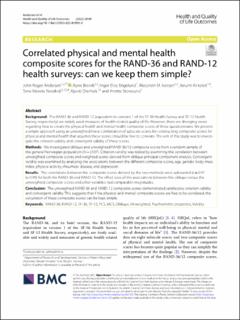| dc.contributor.author | Andersen, John Roger | |
| dc.contributor.author | Breivik, Kyrre | |
| dc.contributor.author | Engelund, Inger Elise | |
| dc.contributor.author | Iversen, Marjolein M. | |
| dc.contributor.author | Kirkeleit, Jorunn | |
| dc.contributor.author | Norekvål, Tone Merete | |
| dc.contributor.author | Oterhals, Kjersti | |
| dc.contributor.author | Storesund, Anette | |
| dc.date.accessioned | 2022-11-15T14:26:11Z | |
| dc.date.available | 2022-11-15T14:26:11Z | |
| dc.date.created | 2022-09-12T16:19:02Z | |
| dc.date.issued | 2022-06-03 | |
| dc.identifier.issn | 1477-7525 | |
| dc.identifier.uri | https://hdl.handle.net/11250/3031975 | |
| dc.description.abstract | Background: The RAND-36 and RAND-12 (equivalent to versions 1 of the SF-36 Health Survey and SF-12 Health Survey, respectively) are widely used measures of health-related quality of life. However, there are diverging views regarding how to create the physical health and mental health composite scores of these questionnaires. We present a simple approach using an unweighted linear combination of subscale scores for constructing composite scores for physical and mental health that assumes these scores should be free to correlate. The aim of this study was to investigate the criterion validity and convergent validity of these scores.
Methods: We investigated oblique and unweighted RAND-36/12 composite scores from a random sample of the general Norwegian population (N = 2107). Criterion validity was tested by examining the correlation between unweighted composite scores and weighted scores derived from oblique principal component analysis. Convergent validity was examined by analysing the associations between the different composite scores, age, gender, body mass index, physical activity, rheumatic disease, and depression.
Results: The correlations between the composite scores derived by the two methods were substantial (r = 0.97 to 0.99) for both the RAND-36 and RAND-12. The effect sizes of the associations between the oblique versus the unweighted composite scores and other variables had comparable magnitudes.
Conclusion: The unweighted RAND-36 and RAND-12 composite scores demonstrated satisfactory criterion validity and convergent validity. This suggests that if the physical and mental composite scores are free to be correlated, the calculation of these composite scores can be kept simple. | en_US |
| dc.language.iso | eng | en_US |
| dc.publisher | BMC | en_US |
| dc.rights | Navngivelse 4.0 Internasjonal | * |
| dc.rights.uri | http://creativecommons.org/licenses/by/4.0/deed.no | * |
| dc.title | Correlated physical and mental health composite scores for the RAND-36 and RAND-12 health surveys: can we keep them simple? | en_US |
| dc.type | Journal article | en_US |
| dc.type | Peer reviewed | en_US |
| dc.description.version | publishedVersion | en_US |
| dc.rights.holder | Copyright 2022 the authors | en_US |
| dc.source.articlenumber | 89 | en_US |
| cristin.ispublished | true | |
| cristin.fulltext | original | |
| cristin.qualitycode | 1 | |
| dc.identifier.doi | 10.1186/s12955-022-01992-0 | |
| dc.identifier.cristin | 2050945 | |
| dc.source.journal | Health and Quality of Life Outcomes | en_US |
| dc.identifier.citation | Health and Quality of Life Outcomes. 2022, 20, 89. | en_US |
| dc.source.volume | 20 | en_US |

